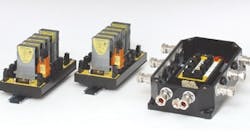Before 1999, early adopters seeking to apply fieldbus had few choices beyond ordinary terminal blocks. Terminal blocks of all types would all be perfectly acceptable for two-wire buses such as Profibus PA and Foundation fieldbus (FF). Unlike Ethernet, which requires independently powered, active devices such as hubs or switches at every junction or branch of its network, process fieldbuses share the same two conductors, with no requirement for intervening circuitry or silicon. With the majority of field devices largely deriving their power from the same pair of conductors, this makes two-wire buses such as FF and PA natural choices for the process industries, where the reward for high availability is extraordinary.
[pullquote]A minority of users employ simple terminals for two-wire fieldbus because a short circuit anywhere in the network causes every device on the bus—as many as 32—to lose power and communications and revert to its "shelf" state. While some buses have enough intelligence to accommodate some "graceful degradation" when a device unexpectedly powers down and ceases to function, there's nothing graceful about a control valve or other final element going to its fail position—which is where it goes on loss of two-wire power. When one or two or more control valves are suddenly traveling to their fail positions and perhaps remaining there for a minute or more, it's likely to have some immediate and unhappy effects on the reliability and productivity of the process.
In most cases, this is a self-inflicted injury, as when a technician or electrician is servicing a device or adding devices to an existing segment. So it can be argued that a well-trained and disciplined workforce can effectively avoid the consequences. But the traditions and habits from decades of 4-20 mA, as well as the uncertainties of succession in our craft workforce, makes us desire an engineered bit of insurance.
Enter the coupler.
The purpose of a coupler, aside from being a handy gadget for landing the segment's trunk and spurs, is to imbue the segment with this engineered layer of fault tolerance. Incidently, every coupler listed on the fieldbus.org site works equally well on both FF and Profibus PA networks. The circuitry on the coupler ensures that if a short circuit occurs on any spur, it is prevented from causing the other devices on the segment from failing. They cost a bit more than simple terminals, but the installed cost is still low compared to point-to-point wiring.
As an added benefit, by engineering a current-limiting circuit into spurs, the couplers also provide hazardous-area capability for the installation. Most vendors offer versions that are third-party certified to meet the requirements for NEC non-incendive wiring or various levels of intrinsic safety.
The fieldbus.org site lists 15 couplers that have passed testing and earned a fieldbus "checkmark" for conforming to the foundation's requirements. So, are they all equal commodities that can be specified and procured on the basis of cost only? It's interesting that, even on the relatively passive level of fieldbus couplers, distinctions can be significant. From the compact and spartan Cobalt CDC8 to the clever, redundant-trunk capable offerings of MooreHawke Trunksafe, features that address differing priorities, practices and tastes are worth examining. Next month, we'll survey these offerings.






